
Being successful in Magic requires more than just being good at the game itself. Among other things, it requires an understanding of the competition. At its basic level, this means knowing who and what you'll be facing against, but it also means knowing the fundamental structure of the competitive environment. While players spend tons of time analyzing specific metagames in order to determine which deck to play, there hasn't been much exploration of metagames in general. So that's the goal for today: to find out what makes a metagame tick.
Meet Your Meta
In any game of choice where players compete against each other, there is a metagame. Literally, this is a game beyond the game itself, and it is based on predicting the choices that your opponents will make. If you have extra information about the way they make choices, you can use that knowledge to your advantage. For example, when Bart and Lisa play rock-paper-scissors, Lisa knows that Bart will always choose rock. As a result, she can always choose paper against him and win every time.
In Magic, the term "metagame" generally refers to an established field of decks, specific to the format and the group of people playing. At your local FNM, maybe you can expect a majority of aggro decks and a few combo and control decks. This may or may not be the same field of decks expected by other players at their own tournaments. The point is that, when trying to take advantage of the metagame, you have to use information about the field that you're playing in, rather than using information about other fields. Of course, if you don't have any information at all, you might try to apply outside data to your own metagame with the hope that the fields are similar.
There are two key pieces of information needed to study a metagame: the likelihood of each deck winning against any other deck, and the number of appearances of each deck. While the first is definitely important, the second is essential. Maybe your deck is an auto-win against everything except Raffinity, but if you show up to the tournament and everyone else is playing Raffinity, who cares what the rest of your matchups are like?
Some Game Theory, Please
First, let's focus on the matchups. We can use a payoff matrix to represent the probability of each deck winning against a given deck. In a payoff matrix, each row and column represents a particular choice of strategy for each player (in Magic, this is your choice of deck), and the cells show the payoff for each combination of strategies. Here, we'll be assigning the payoffs based on the probability of winning. So if a deck is a 70% favorite over another, its payoff is .70, and the other deck would have a payoff of .30.
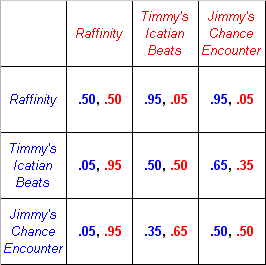
Each deck's expected payoff is its probability of winning against a random opponent. If we assume that it has an equal chance of facing any of these three decks, then the expected payoff is simply the average of the payoffs for each individual matchup. So Raffinity's expected payoff is (1/3)*(.50 + .95 + .95) = .80, the Icatian Beats' expected payoff is (1/3)*(.05 + .50 + .65) = .40, and the Chance Encounter deck's expected payoff is (1/3)*(.05 + .35 + .50) = .30. So based purely on expected payoff, the best deck choice is Raffinity.
We can also classify Raffinity here as being a dominant strategy. Notice that no matter which strategy Player 2 chooses, Player 1 gets the highest payoff when choosing Raffinity (compare the blue numbers in each column, and you'll see that the largest number is always in the Raffinity row). When a player has a dominant strategy, that player should always choose that strategy, regardless of everything else. And in this case, it also means that every player should play Raffinity, leading to a metagame filled with that deck and nothing else.
Rock, Paper, Scissors
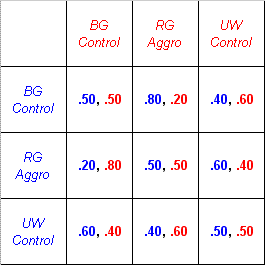
Based on expected payoff in an evenly distributed field, BG Control has a slight advantage (having about a .57 expected payoff, compared to .43 for RG Aggro and .50 for UW Control). So in a random field, it seems that BG Control stands the best chance of winning. As a result, players will tend to play that deck more. But what happens if everyone plays it?
In a field consisting of only BG Control, every deck will have a 50% chance of winning any matchup (because it's always a mirror match). So the expected payoff for BG Control is now only .50. An observant player might notice this, and decide to switch to UW Control. His expected payoff in this metagame would be .60, since he would only be facing off against BG Control. So now UW Control has the advantage!
Others notice this, and at the next tournament, everyone switches over to UW Control. Once again, they find themselves in a field of mirror matches, bringing everyone's expected payoff back to .50. That one observant player sees this, and discovers an opportunity to take advantage of the situation - this time by playing RG Aggro. Against a field of only UW Control decks, the RG Aggro deck has a better expected payoff than any other deck.
This continues when everyone switches to RG Aggro, while a few players realize that returning to BG Control is the best choice in a metagame filled with RG Aggro decks. And the cycle can continue. This is an example of the classic "Rock, Paper, Scissors" model, where each deck beats one other deck in a cycle. Choosing a strategy is no longer as simple as looking for a dominant one; now a choice needs to be made based on predictions of what everyone else is playing. Some will play BG Control because it seems to naturally be the strongest in an unknown field (though we'll see later that it's not). Some will play UW Control with the expectation of a large amount of BG Control, and some others will play RG Aggro based on their expectation of UW Control decks.
Mixing It Up
To model a tournament metagame, we'll treat the individual as Player 1 and the overall field as Player 2. Player 1 will choose a pure strategy, which means that a single choice is fixed for the whole game (since you can't change decks in the middle of a tournament). Player 2, on the other hand, will play a mixed strategy, which means that it chooses a probability distribution over all of the choices. This probability distribution is dependent on how many decks of each type are appearing in the field.
For example, suppose there are 300 players, with 100 choosing each of the deck types in the previous example (BG Control, RG Aggro, and UW Control). So the probability distribution for Player 2 is (.33, .33, .33). This means that you'll expect to face each deck one-third of the time. You can calculate your expected payoff against this field (we did this earlier), and it shows BG Control having a slight advantage at .57. If the probability distribution for Player 2 was instead (.60, .10, .30), the expected payoffs are:
BG Control: .60*.50 + .10*.80 + .30*.40 = .50
RG Aggro: .60*.20 + .10*.50 + .30*.60 = .35
UW COntrol: .60*.60 + .10*.40 + .30*.50 = .55
So UW Control would now be a better choice, which makes sense since there's a very large number of BG Control decks in the field.
As you can see, the popularity of each deck makes a very big difference in determining which deck has the best chance of succeeding. Predicting the metagame is very important. While one deck might look good when facing an evenly distributed metagame, it could easily be a bad choice in an uneven metagame.
Got Swiss?
While the model so far is a start, it's still a little too simplistic. Right now, it can only tell you which deck has the best chance if you were to play a single match against a random deck in the field. But that's hardly an accurate representation of a tournament. You'll be playing several rounds, and the distribution of the decks in each round will change. Because of the nature of the Swiss-style tournament structure, weaker decks will get filtered out by the later rounds. This means that if you're looking to win, you need to understand how the field will change as you move up in the standings.
Essentially, you can treat each point level as its own miniature metagame. At the start, all the decks are at the 0-point level, so you're looking at the whole metagame. After the first round, about half of the decks will move up to the 3-point level. This field will likely not be the same as the original field. To see what it looks like, do the following:
1) Calculate the expected payoff for each deck in the previous field.
2) Multiply each deck's payoff by its percentage of the field, then multiply by 2.
For example, let's use the (.60, .10, .30) distribution we calculated in the previous section. BG has an expected payoff of .50, RG has an expected payoff of .35, and UW has an expected payoff of .55. That means we can expect 50% of the BG decks to win, along with 35% of the RG decks, and 55% of the UW decks. So the new field will look like:
BG Control: .50*.60 = .30 => .30 * 2 = .60 (60% of the field)
RG Aggro: .35*.10 = .035 => .035 * 2 = .07 (7% of the field)
UW Control: .55*.30 = .165 => .165 * 2 = .33 (33% of the field)
As you can see, BG maintained its percentage of the field, while fewer RG decks and more UW decks advanced. If we continued this analysis, we could see an interesting trend for this tournament:

Notice that as the number of RG decks decreases, the field becomes only BG and UW decks, and in that type of field, UW has a distinct advantage. So while BG Control has a higher expected payoff in the first round against an evenly distributed metagame, UW Control may perform much better in an actual tournament.
Keep in mind that these are percentages, not the actual number of decks. Since there are only a fixed number of slots at each point level, the actual numbers will obviously be different. But this at least gives you a better way to predict what will be at the top. (One interesting thing is that if you had an infinitely large metagame, and you ran an infinite number of rounds, you would see a definite cycle. At some points, the field would be mostly UW, at other points it would be mostly RG, and at other times it would be mostly BG.)
Let's look at some sample trends for an 8-round tournament based on different initial distributions:
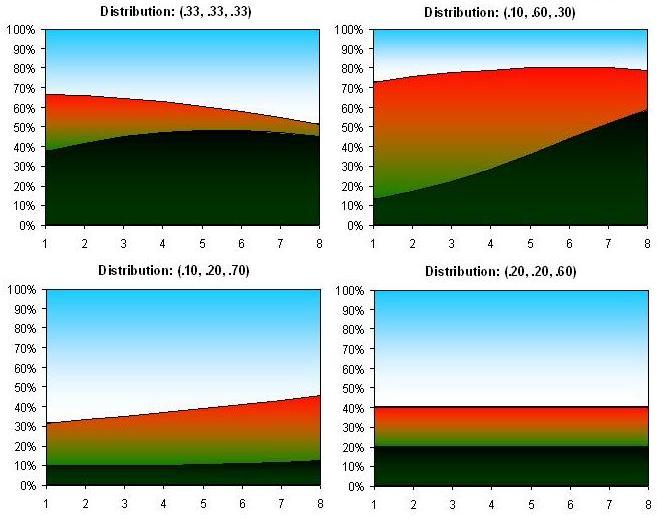
The first graph shows that even if the tournament started with an even distribution of decks, UW Control will outperform the other decks by Round 8, despite BG Control getting off to a better start.
Notice that the last graph shows a constant distribution. This happens to be the equilibrium for this payoff matrix. Interestingly enough, every finite payoff matrix has an equilibrium, as mathematician John Nash famously proved. In Magic, an equilibrium metagame means that every player has an expected payoff of .50; in other words, each player is equally likely to win or lose the next match (before knowing who the opponent is).

You can expand a payoff matrix to include as many decks as you need to describe your metagame. Things do get more complicated, but the basic ideas remain the same. A sample metagame with four different decks is shown on the right, and here are the expected payoffs against an even distribution of decks:
Deck A: (1/4)*(.50 + .60 + .30 + .50) = .475
Deck B: (1/4)*(.40 + .50 + .80 + .30) = .50
Deck C: (1/4)*(.70 + .20 + .50 + .80) = .55
Deck D: (1/4)*(.50 + .70 + .20 + .50) = .475
So Deck C performs best against a completely even field. But let's look at some graphs of what happens in an 8-round tournament with different initial distributions:
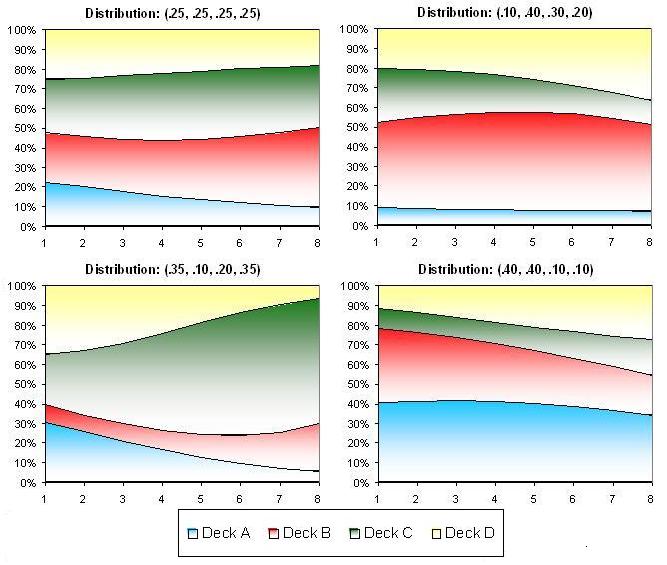
Again, each deck's performance depends greatly on the initial metagame.
What the Tech?
Once you've made your predictions of what the initial metagame will look like (and what the later rounds will look like), you now have to decide which deck to play. You'll want to calculate the expected payoff of each deck at each level to get an idea of which one will perform best overall.
Remember that the payoffs aren't set in stone. Although you'll have to use general numbers for the payoff matrices (since you don't know exactly what the opposing decks will look like), your own deck can have its own unique payoff matrix against the field. Even if you fall under one of the archetypes listed, your specific sideboard and your playskill can factor into your win percentage. For example, if you feel you have an edge in skill over the general level of competition, you might boost your win percentages slightly against all other decks.
But rather than making assumptions about your skill level relative to the field, you should focus mostly on your specific build and your sideboard. When choosing which deck to play, you'll need to make different payoff matrices for different possible configurations of a deck. A deck with an anti-control sideboard will perform differently from the same deck without an anti-control sideboard. By adjusting your sideboard, you can modify your win percentages to account for the expected metagame.
You'll have to decide which matchups you want to improve and which ones you can sacrifice. Antoine Ruel, and others playing Owling Mine at PT Honolulu, knew that his matchup against aggro decks was weak. Based on his expectation of a heavy control metagame, he figured he could sacrifice the aggro matchup to gain a more favorable control matchup. He realized that even if he were to use his sideboard to improve his game against aggro, the payoff increase was too small to really make a difference. Unfortunately for him, aggro decks did better than most people predicted, and he entered the quarterfinals with a heavily disadvantaged matchup. But he still played his odds well and earned a T8 for it.
Keep in mind that everyone else is possibly tweaking their own decks as well. Just as you have your own unique payoff matrix against the aggregate field, so do they. Theoretically, if you knew every single decklist that was going to appear, and you knew each deck's payoff against every other deck, you could create a payoff matrix with hundreds of rows and columns. But that's pretty impractical, so you need to simplify things. You can still break down decks into significant variants to get finer results. For example, you might separate Deck A builds geared more towards anti-control from Deck A builds geared more towards anti-aggro, as long as they have different payoffs. In general, though, you'll have to base your payoff matrices on "average" results against an expected "typical" build.
You also need to keep ahead of the shifting metagame. When the deck you're playing is performing well, it'll likely become a target for other decks. You can reasonably expect that other decks will be trying to improve their payoffs against you. Of course, that likely means they're sacrificing their payoffs against other decks. If enough of them make a large shift in their payoffs, you'll need to account for that in your payoff matrix and your resulting analysis of the metagame trends.
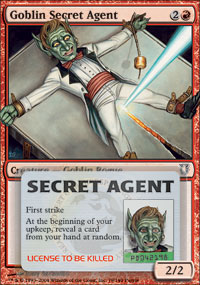
I'm not looking to get into a debate about rogue-decking, but I will say this: playing a rogue deck does not mean playing a bad deck. Yes, some people play bad decks of their own creation, but that's not the same as competitive rogue-decking. One of the primary goals of going rogue should be to take advantage of an observed weakness in the metagame.
There have been many metagames that have been broken in half by something unexpected. The majority of the field is choosing their decks based on previous metagames, so all their testing has been focused on those fields and improving the established matchups. The rogue, on the other hand, looks at the strongest decks in the field and finds a deck with a very high payoff against those decks. Obviously, there's generally a risk involved because the rogue deck may have only an average or weak game against other minor decks in the field. But if the rogue manages to survive past the first couple rounds, there's a good chance those weaker decks will have been filtered out, leaving the deck to face only its targeted matchups.
Reading the Results
It should come as no surprise that metagame predictions rely heavily on previous tournament results, whether offline or online (and MTGO is becoming an increasingly strong indicator for metagames in major tournaments). Players generally focus on T8 placings to determine which decks are good. But I always feel that there's a little too much emphasis placed on those eight decks, and not enough on the rest of the field.
To be honest, the T8 of a large tournament is not a very big number. In a field of 300 players, T8 represents less than 3% of the competition. And even if there were several viable deck types, it's very likely that some won't reach the T8, despite being strong, simply because only eight decks can make it.
Players shouldn't be looking at just the T8, or even the T16 or T32. Sure, those are good places to start, as you can see which decks have the capability of surviving a particular metagame. But you still need to know what kind of metagame it was. Were there a lot of control decks? Was it dominated by aggro? What were the most popular decks at the start? Was each deck overrepresented or underrepresented in the T8?
I hope it's clear from the graphs earlier in the article that there's more to winning than just picking a good deck. In reality, a tournament is an exercise in playing out the odds. Those who are better players and those with better decks are more likely to end up at the top, but their chances of winning depend on the circumstances.
I think a lot of people make the mistake of adhering too strongly to the tournament results when judging decks - that if a deck appears in the T8, it must be one of the top decks. Or similarly, if a deck fails to reach the T8, it must not be one of the top decks. Without understanding the field the deck faced, both of those statements aren't very reliable.
Some Final Thoughts
There's still a lot of work to be done in understanding metagames. In the end, the mathematical models I've used are attempts to simplify a very complex thing into something more understandable and easier to analyze. The model can definitely be expanded for accuracy, taking into account other things, such as looking at not just the mini-metagame of the undefeated decks, but also at those with only one loss. And as it is, performing the analysis still requires human guesswork, since being able to closely predict the initial metagame will greatly influence your predictions for the later rounds. Meanwhile, constructing payoff matrices can be a daunting task, as metagames are often much larger than just a handful of decks.
Probabilistic models aren't perfect, as they can only tell you what to expect, not predict exactly what will happen. And since the mini-metagames at each level depend on the expectations of the previous level, you'll find that any actual deviation from the expected field can potentially ruin any of the analysis you've done. Thankfully, most metagames aren't that sensitive, and general trends will apply across most possible scenarios. At the least, it's better than just taking blind guesses at what you'll be facing during a tournament, and you can still spot tendencies that can guide your metagaming decisions.
In the end, metagaming is all about doing your homework. You need to find out as much as you can about the potential field and your potential matchups. Understanding the anatomy of the metagame will help you better utilize that research. With the proper work, you'll be one step closer to ultimate success. Just remember that when you sit down at the table and shuffle your cards, that's just one half of the game of Magic. The other half starts with the metagame.
-fadeblue
Comments